|
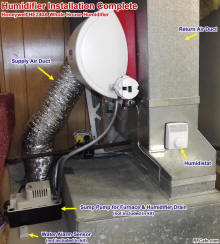 A large portion of the U.S. has experienced
prolonged periods this winter (2014) with temperatures substantially below long-term
averages. That means heating systems have been running much more often than usual,
and if you have a forced hot air system, that means the indoor humidity level has
been much lower than normal. In northern areas like where I live, humidity can easily
drop to near zero. Because of that, triboelectric charging to high voltage potential
occurs merely by walking a few steps across a carpet, resulting in a sometimes painful
discharge arc when a metal object is touched. A large portion of the U.S. has experienced
prolonged periods this winter (2014) with temperatures substantially below long-term
averages. That means heating systems have been running much more often than usual,
and if you have a forced hot air system, that means the indoor humidity level has
been much lower than normal. In northern areas like where I live, humidity can easily
drop to near zero. Because of that, triboelectric charging to high voltage potential
occurs merely by walking a few steps across a carpet, resulting in a sometimes painful
discharge arc when a metal object is touched.
The only way to mitigate low humidity conditions is to add water back into the
air. One way is to use a free-standing humidifier that either evaporates water back
into the air or to use an ultrasonic humidifier that blows a fine water mist into
the air, which then evaporates. Ultrasonic types tend to put more water back into
the air, but if you have a high chemical content in your water - such as lime or
calcium - you will soon find a layer of dust deposited on everything in your house.
It lays on top of horizontal surfaces and electrostatically clings to the sides
of glass and plastic - an utter mess!
Evaporative humidifiers do not have that problem since the heavy, non-evaporative
elements never leave the unit. Instead, they collect on the filter/dispersion grid.
Cleaning or replacement is needed, but at least the crud is not all over everything
else.
You can buy free-standing humidifiers of both types that have water supply line
hookups with valves that regulate water inflow, but you need to have them located
near a supply line. Regardless of the type, you will be listening to fans blowing
all day and night long.
The preferred option, IMHO, is to install a whole-house humidifier that resides
on the furnace ductwork, has its own regulated water supply, and is controlled by
a humidistat. After a couple weeks of refilling three free-standing humidifiers
two to three times a day and listening to the fans, I decided it would be worth
the expense and effort to install a whole-house humidifier. The free-standing units
cost $60 at Walmart ($180 total), and the Honeywell HE240A whole-house humidifier
with a couple additional parts cost a total of around $225 at Home Depot. I already
had the small sump pump to handle the water drain, so that saved me $40. I could
have run the drain line into the garage floor drain, but that would have looked
bad. So, after about six hours of installation time and an additional $50, I now
have an automatic humidifier that waters itself and probably adds at least $225
of resale value to my house. The three free-standing units, which would have no
resale value, were cleaned and returned to Walmart for a full refund.
Installation is very simple if you have all the needed tools, which I did. Instructions
called for a 3/4" diameter metal drill, but I instead marked off a 3/4" hole and
drilled around the perimeter with a 3/32" bit and filed the edges smooth. Because
of the vertical downward flow of my furnace, I needed to mount the humidifier unit
on the return air duct. Here are a few photos of the installation in case you want
to try a similar installation for yourself. I'm guessing anyone who reads this,
being an RF Cafe visitor, will have no problem.
Note: High efficiency fuel-fired furnaces generate water in the exhaust due to
condensation from the air. It is the same process that condenses air in your air
conditioner. It needs to be drained properly. Mine originally drained into the soil
under the house, but I re-routed it into the sump pump used for the humidifier drain.
BTW, my furnace uses natural gas - the cheapest of all fuel sources these days.
I pity those who use oil, LP, or propane!
|

Here is the completed whole-house humidifier system installation.
My house is only 960 ft2, so the Honeywell model
HE240A, which handles up to 1,500 ft2, has plenty of
capacity to spare.
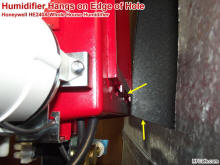
Hang the humidifier body on the bottom of the duct opening.
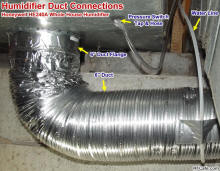
Mark and cut hole in duct for 6" diameter duct tap. Pressure
switch tap requires 3/4" hole with a grommet and nipple for hose.
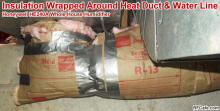
Insulation wrapped around duct and water line.
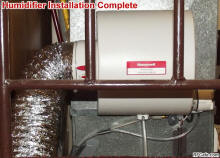
Whole-house humidifier installation front view.
|
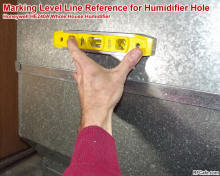
Use a level to mark a reference line. Don't measure relative
to the duct because it might not be level or plumb. The humidifier body needs to
be level to assure proper drainage.
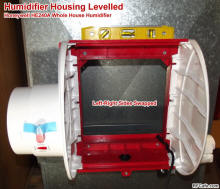
Level before installing screws. I needed to swap the left and
right sides for my configuration.
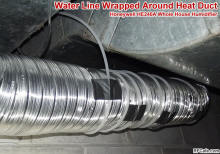
Although not required, I looped the water line around the heat
duct to pre-heat the water before entering the humidifier.
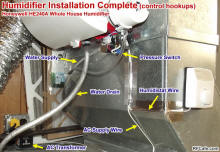
Details of pneumatic, hydraulic, and electrical hookups.
|
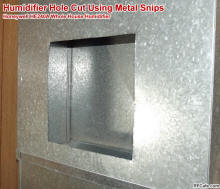
Drill 1/2" holes at the four corners and use metal snips to cut
the hole, then use pliers to flatten the edges where the snips curled them.
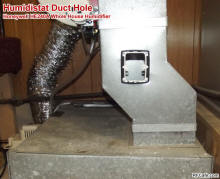
Mark and cut the humidistat hole.
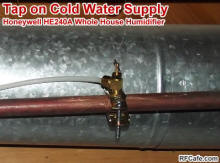
Tap installed on cold water supply pipe (same type as for refrigerator
ice maker).
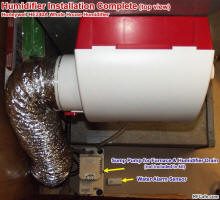
Whole-house humidifier installation overhead view. The sump pump
has a 1/2" hose running over to my washing machine drain pipe (about 20' away).
|
Posted August 5, 2021
(updated from original post on 2/20/2014)
|






















